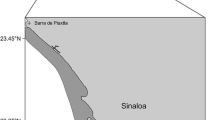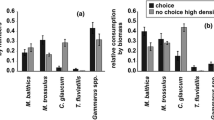Abstract
We evaluated discard consumption by Kelp Gulls (Larus dominicanus) and Black-browed Albatrosses (Thalassarche melanophrys) associated with trawlers operating at Golfo San Jorge, Argentina, and assessed differences in their feeding behaviour, prey size preferences and foraging efficiency. Observations were made onboard hake (January 2007) and shrimp vessels (November 2008). The Kelp Gull and Black-browed Albatross were the most frequent and abundant seabirds at both fisheries, while Argentine Hake (Merluccius hubbsi) dominated the composition of discards. Kelp Gulls and Black-browed Albatrosses consumed 91% of experimentally discarded hake (n = 1236). Mean sizes of prey consumed by gulls were 22.4 and 23.7 cm in the hake and shrimp fisheries, respectively, while those of prey consumed by albatrosses were 28.5 and 31.3 cm, respectively. In both fisheries, gulls selected the smaller prey available (<25 and < 30 cm in hake and shrimp fisheries, respectively) while Black-browed Albatrosses selected the larger prey available (>25 and >30 cm in hake and shrimp fisheries, respectively). Intraspecific and interspecific kleptoparasitism were significantly more frequent than expected in Kelp Gulls and Black-browed Albatrosses, respectively. Robbing efficiency was clearly higher in albatrosses than gulls. In both species, sizes of prey consumed by direct capture were significantly smaller than those stolen, and the rate of kleptoparasitism increased with prey size. Gulls stole significantly smaller prey than albatrosses. Prey selection by Kelp Gulls is affected by the interaction with Black-browed Albatrosses, and the degree at which discards are used by both species appears to depend on the fishery considered, the food on offer and the selection of prey sizes according to seabird species-specific preferences.
Zusammenfassung
Wir untersuchten den Verzehr von Abfällen durch Schwarzbrauenalbatrossen (Thalassarche melanophrys) und Dominikanermöwen (Larus dominicanus) an Schleppnetzfischerbooten im Golfo San Jorge in Argentinien und beobachteten Unterschiede in ihrem Futterverhalten, Größenpräferenzen und Effizienz. Beobachtungen wurden an Bord von Seehecht- (Januar 2007) und Krabbenkuttern (November 2008) gemacht. Dominikanermöwen und Schwarzbrauenalbatrosse begleiteten die Boote am häufigsten und waren die zahlreichsten Seevögel. Der Argentinische Seehecht (Merluccius hubbsi) machte den Großteil der Abfälle aus. Dominikanermöwen und Schwarzbrauenalbatrosse verzehrten 91% der experimentell ausgebrachten Seehechte (n = 1236). Die mittlere Größe der durch Möwen verschlungenen Nahrung betrug 22,4 cm in der Seehecht- und 23,7 cm in der Krabbenfischerei, während die Beute der Albatrosse 28,5 bzw. 31,3 cm maß. In beiden Fischereiarten wählten Dominikanermöwen die kleinere Beute (<25 und <30 cm in Seehecht- bzw. Krabbenfischerei), während Schwarzbrauenalbatrosse die größeren Beutestücke wählten (>25 und >30 cm in Seehecht- bzw. Krabbenfischerei). Intra- und interspezifischer Kleptoparasitismus war in beiden Arten signifikant häufiger als erwartet. Die Effizienz beim Kleptoparasitismus war bei Albatrossen sichtbar größer als bei Möwen. Bei beiden Arten waren die direkt gefangenen Beutestücke signifikant kleiner, als die durch Kleptoparasitismus erbeuteten, und die Kleptoparasitismusrate nahm mit der Größe der vorhandenen Beute zu. Möwen stahlen signifikant kleinere Beutestücke als Albatrosse. Die Wahl der Beute durch Dominikanermöwen ist durch die Interaktionen mit Schwarzbrauenalbatrossen beeinflusst und das Ausmaß, in dem Abfälle genutzt werden, scheint bei beiden Arten von der Art der Fischerei abzuhängen, bedingt durch unterschiedliches Nahrungsangebot und die artspezifische Präferenz für bestimmte Beutegrößen.



Similar content being viewed by others
References
Alverson DL, Freeberg MH, Murawski SA, Pope JG (1994) A global assessment of fisheries bycatch and discards (FAO Fisheries Tech Paper no. 339). FAO, Rome, 233 pp
Arcos JM, Oro D, Sol D (2001) Competition between the yellow-legged gull Larus cachinnans and Audouin’s gull Larus audouinii associated with commercial fishing vessels: the influence of season and fishing fleet. Mar Biol 139:807–816
Ashmole NP, Ashmole MJ (1967) Comparative feeding ecology of seabirds of a tropical oceanic island. Peabody Mus Nat Hist Yale Univ Bull 24:1–131
Aubone A, Bezzi SI, Cañete G, Castrucci R, Dato D, Irusta G, Madirolas A, Pérez M, Renzi M, Santos B, Simonazzi M, Villarino MF (2004) Evaluación y sugerencias de manejo del recurso merluza (Merluccius hubbsi). La situación hasta 1999. In: Sánchez RP, Bezzi SI (eds) El Mar Argentino y sus recursos pesqueros. Tomo 4. Los peces marinos de interés pesquero. Caracterización biológica y evaluación del estado de explotación (Special Publications INIDEP). INIDEP, Mar del Plata, pp 207–235
Bertellotti M, Yorio P (2000a) Age-related feeding behaviour and foraging efficiency in Kelp gulls Larus dominicanus attending coastal trawlers in Argentina. Ardea 88(2):207–214
Bertellotti M, Yorio P (2000b) Utilization of fishery waste by Kelp Gulls attending coastal trawl and longline vessels in northern Patagonia, Argentina. Ornis Fennica 77:105–115
Bertellotti M, Yorio P (2001) Intraspecific host selection by kleptoparasitic Kelp Gulls in Patagonia. Waterbirds 24(2):182–187
Bezzi S, Renzi M, Irusta G, Santos B, Tringali L, Ehrlich M, Sánchez F, Rosa SGdl, Simonazzi M, Castrucci R (2004) Caracterización biológica y pesquera de la merluza (Merluccius hubbsi). In: Sánchez RP, Bezzi SI (eds) El Mar Argentino y sus recursos pesqueros. Tomo 4. Los peces marinos de interés pesquero. Caracterización biológica y evaluación del estado de explotación (Special Publications INIDEP). INIDEP, Mar del Plata, pp 157–205
Bo NA, Darrieu CA, Camperi AR (1995) Aves Charadriiformes: Laridae y Rynchopidae. In: Fauna de agua dulce de la República Argentina, vol 43 (4c). PROFADU (CONICET), La Plata, pp 1–47
Brockmann HJ, Barnard CJ (1979) Kleptoparasitism in birds. Anim Behav 27:487–514
Camphuysen CJ, Calvo B, Durinck J, Ensor K, Follestad A, Furness RW, Garthe S, Leaper G, Skov H, Tasker ML, Winter CJN (1995) Consumption of discards by seabrids in the North Sea (Final Report EC DG XIV Research Contract BIOECO/93/10; NIOZ Rapport 1995–5). Netherlands Institute for Sea Research, Texel
Catchpole TL, Frid CLJ, Gray TS (2006) Importance of discards from the English Nephrops norvegicus fishery in the North Sea to marine scavengers. Mar Ecol Prog Ser 313:215–226
Cordo H (2005) Evaluación del estado del efectivo sur de 41°S de la merluza (Merluccius hubbsi) y estimación de la captura biológicamente aceptable correspondiente al año 2005 (INIDEP Tech Report 37). INIDEP, Mar del Plata
Favero M, Blanco G, Garcia G, Copello S, Seco JP, Frere E, Quintana F, Yorio P, Rabuffetti F, Cañete G, Gandini P (2010) Seabird mortality associated to ice trawlers in the Patagonian Shelf: effects of discards in the occurrence of interactions with fishing gear. Anim Conserv doi: https://doi.org/10.1111/j.1469-1795.2010.00405.x
Furness RW (1987) Kleptoparasitism in seabirds. In: Croxall JP (ed) Seabirds feeding, ecology and role in marine ecosystems. Cambridge University Press, Cambridge, pp 77–100
Furness RW, Hudson AV, Ensor K (1988) Interactions between scavenging seabirds and commercial fisheries around the British Isles. In: Burger J (ed) Seabird and other marine vertebrates: competition, predation and other interactions. Columbia University Press, New York, pp 240–268
Furness RW, Edwards AE, Oro D (2007) Influence of management practices and of availability of fisheries discards to benthic scavengers. Mar Ecol Prog Ser 350:235–244
Garthe S, Hüppop O (1998) Possible biases in experiments evaluating the consumption of discards by seabirds in the North Sea. Mar Biol 131:735–741
Garthe S, Scherp B (2003) Utilization of discards and offal from commercial fisheries by seabirds in the Baltic Sea. ICES J Mar Sci 60:980–989
Garthe S, Camphuysen K, Furness R (1996) Amounts of discards by commercial fisheries and their significance as food for seabirds in the North Sea. Mar Ecol Prog Ser 136:1–11
Gatto AJ, Yorio P (2009) Provisioning of mates and chicks by Cayenne and Royal Terns: resource partitioning in northern Patagonia, Argentina. Emu 109:49–55
González-Zevallos D, Yorio P (2006) Seabird use of discards and incidental captures at the Argentine hake trawl fishery in the Golfo San Jorge, Argentina. Mar Ecol Prog Ser 316:175–183
González-Zevallos D, Yorio P, Caille G (2007) Seabird mortality at trawler warp cables and a proposed mitigation measure: a case of study in Golfo San Jorge, Patagonia, Argentina. Biol Conserv 136:108–116
Gotelli NJ, Entsminger GL (2001) EcoSim: null models software for ecology, v.7.0. Acquired Intelligence Inc./Kesey-Bear, Jericho (see http://homepages.together.net/~gentsmin/ecosim.htm)
Gremillet D, Wilson RP, Wanless S, Chater T (2000) Black-browed albatrosses, international fisheries and the Patagonian Shelf. Mar Ecol Prog Ser 195:269–280
Hackl E, Burger J (1988) Factors affecting piracy in Herring gulls at a New Jersey landfill. Wilson Bull 100(3):424–430
Harrison CS (1990) Seabirds of Hawaii: natural history and conservation. Cornell University Press, Ithaca
Hockey PAR, Ryan PG, Bosman AL (1989) Age related intraspecific kleptoparasitism and foraging success of Kelp Gulls Larus dominicanus. Ardea 77(2):205–210
Hudson AV, Furness RW (1989) The behaviour of seabirds foraging at fishing boats around Shetland. Ibis 131:225–237
Hulsman K (1976) The robbing behaviour of terns and gulls. Emu 76:143–149
Hulsman K (1984) Selection of prey and success of Silver Gulls robbing Crested Terns. Condor 86:130–138
Hulsman K (1988) The stucture of seabird communities: an example from Australian waters. In: Burger J (ed) Seabirds and other marine vertebrates. Competition, predation and other interactions. Columbia University Press, New York, pp 59–91
Krebs CJ (1989) Ecological methodology. Harper and Collins, New York
Montevecchi WA (2002) Interactions between fisheries and seabirds. In: Schreiber EA, Burger J (eds) Biology of marine birds. CRC Press, Washington, DC, pp 527–555
Onley D, Bartle S (1999) Identificación de aves marinas de los Océanos del Sur. Una guía para observadores científicos a bordo de buques pesqueros. Te Papa Press en asociación con la Comisión para la Convención sobre la Conservación de los Recursos Vivos Marinos de la Antártica. Museo de Nueva Zelanda Te Papa Tongarewa
Petyt C (1995) Behaviour of seabirds around fishing trawlers in New Zealand subantarctic waters. Notornis 42:99–115
Ratcliffe N, Richardson D, Lidstone Scott R, Bond PJ, Westlake C, Stennett S (1997) Host selection, attack rates and success rates for black-headed gull kleptoparasitism of terns. Colon Waterbirds 20:227–234
Robinson JA, Hamer K, Chivers LS (2001) Contrasting brood sizes in Common and Arctic Terns: the roles of food provisioning rates and parental brooding. Condor 103:108–117
Ryan PG, Moloney CL (1988) Effect of trawling on bird and seal distributions in the southern Benguela region. Mar Ecol Prog Ser 45:1–11
Subsecretaría de Pesca y Acuicultura (2007) Pesquerías de calamar y langostino: situación actual. Secretaría de Agricultura, Ganadería, Pesca y Alimentos de la República Argentina, Buenos Aires
Tasker M, Camphuysen CJ, Cooper J, Garthe S, Montevecchi WA, Blaver SJM (2000) The impacts of fishing on marine birds. ICES J Mar Sci 57:531–547
Thompson KR (1992) Quantitative analysis of the use of discards from squid trawlers by Black-browed Albatrosses Diomedea melanophris in the vicinity of the Falkland Islands. Ibis 134:11–21
Thompson KR, Riddy MD (1995) Utilization of offal and discards from “finfish” trawlers around the Falkland Islands by Black-browed Albatross Diomedea melanophris. Ibis 137:198–206
Wunderle JM (1991) Age-specific foraging proficiency in birds. In Power DM (ed) Current ornithology. Plenum, New York, 8:273–324
Yorio P (2000) Breeding seabirds of Argentina: conservation tools for a more integrated and regional approach. Emu 100:367–375
Yorio P, Caille G (1999) Seabird interactions with coastal fisheries in Northern Patagonia: use of discards and incidental captures in nets. Waterbirds 22:207–216
Yorio P, Bertellotti M, Gandini P, Frere E (1998) Kelp Gulls (Larus dominicanus) breeding on the Argentine coast: population status and relationship with coastal management and conservation. Mar Ornithol 26:11–18
Acknowledgments
We thank Centro Nacional Patagónico (Consejo Nacional de Investigaciones Científicas y Técnicas) for institutional support, Secretaría de Pesca de la Provincia de Chubut for logistical support and for providing data from the Onboard Observer Program, and the Wildlife Conservation Society for financial support. Special thanks to A. Gatto and M.E. Góngora. We are also grateful to the captains and crews of the hake and shrimp trawlers for their help and advice.
Author information
Authors and Affiliations
Corresponding author
Additional information
Communicated by P. H. Becker.
Rights and permissions
About this article
Cite this article
González-Zevallos, D., Yorio, P. Consumption of discards and interactions between Black-browed Albatrosses (Thalassarche melanophrys) and Kelp Gulls (Larus dominicanus) at trawl fisheries in Golfo San Jorge, Argentina. J Ornithol 152, 827–838 (2011). https://doi.org/10.1007/s10336-011-0657-6
Received:
Revised:
Accepted:
Published:
Issue Date:
DOI: https://doi.org/10.1007/s10336-011-0657-6




